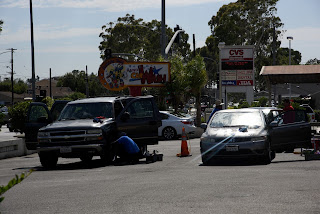The foundation for SNAP (Supplimental Nutrition Assistance Program) was implemented in 1933. It was a "New Deal" program that assisted farmers during the depression where the Federal Government bought food from farmers and redistributed the food to the poor. This program was called the AAA (Agricultural Adjustment Act). This did save many farms from bankruptcy and greatly assisted hunger relief programs at the local level.
The Food Stamp Plan was another "New Deal" program implemented in 1939. Food stamps were made available to low-income individuals and were only to be used for specific nutritional foodstuffs, not for luxury items or alcohol or tobacco. Individuals were required to buy booklets of orange stamps, with each stamp worth $1. For every orange stamp purchased, individuals were given a blue stamp for free that was worth 50 cents. The program was discontinued in 1943, as World War 2 raged and the subsequent economic boom greatly decreased the amount of people living below the poverty line.
In 1961 President Kennedy brought back the food stamp program. The stamps still had to be purchased, and were redeemed for nutritious foodstuffs only. In 1964, the Food Stamp Act was passed as part of Lyndon Johnson's "Great Society Program". It outlawed discrimination for qualification for the program by race, color or creed, but was basically the same old program that had been around for years.
The program funding was cut drastically during the Reagan administration. Also, participation in this new program now officially called SNAP was relegated to the states, with the federal government matching funds. The new regulation also called for individuals to be eligible for participation only if their income is less than 185% of the poverty line. This new program had the effect of drastically cutting eligibility and participation rates.
In the early 2000's, the program changed once again. Eligibility was extended to immigrants and children 18 years old and younger. This spiked participation rates dramatically. EBT cards were introduced, allegedly for the purpose of eliminating fraud and reducing the stigma attached to using government benefits. The card looks like a debit card from any bank, and is used in much the same way.
 |
| Local carwash with two signs showing acceptance of EBT cards |
 |
| Same carwash, not only can you get your car washed, but you can get cash to spend anyway you want. |
45 million Americans are now carrying EBT cards. The Obama administration actually paid for advertisements to entice people to sign up for SNAP, along with eliminating the work requirement. With 14% of the population now on this program, the advertisements and work requirement eliminations were very successful. Allegedly the program is limited to retailers that sell nutritious food, and does not include purchases of luxury items, alcohol, tobacco, or any non-nutrition related services.
 |
| Perfect example of non-nutrition related food stuffs, at local liquor store. |
 |
| Fast food using EBT, the cost of one fast food meal, can feed an entire family if food was purchased and home made. |
Today, carwashes, liquor stores, restaurants, casinos, and banks proudly advertise their acceptance of EBT cards. At banks one can get up to $100 in cash daily. You can get your car washed, a pack of smokes, 6 pack of beer, or a casino bankroll in Las Vegas with your EBT card. In fact, over 20% of EBT purchases are "out of state" at luxury resorts, cruise ships, hotels and restaurants.
 |
| Every liquor store we drove by had a sign advertising acceptance of EBT cards. |
This program is not doing what was originally intended. The abuses are rampant, and something needs to be done. Further, there is no reason why 45 million Americans need to be on this program.
Additionally, there does need to be a stigma for using such a program, and food stamps, although embarrassing, did serve that purpose.
Some states like Alabama are now requiring able bodied people to search for and to accept work in order to be eligible for SNAP. Alabama has shown that this requirement has lessened their participants by 85%. Similar results are shown with other states that are embracing work requirements. This is a step in the right direction. There also needs to have purchase restriction enforcement on what can actually be bought with the program.
Sources:
Fox News July 4, 2017 - Food stamp rolls plummet in states that restore work requirements.
Los Angeles Times Oct. 4, 2010, Jack Dolan author - $69 million in California welfare money drawn out of state.
SNAPtohealth.org - The History of Snap.
EBT Abuse: The Cash-for-Drunkards Program - Jan. 11, 2013 by Michelle Malkin.
Watchdog.Org - EBT fraud and abuse: Looking past your state - July 24, 2012 by Todd Shepard

No comments:
Post a Comment